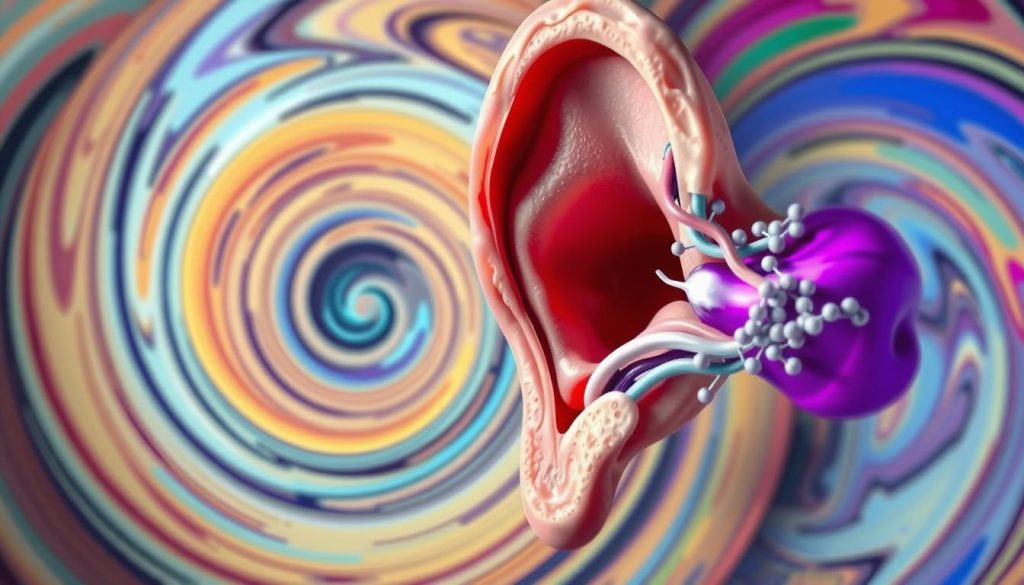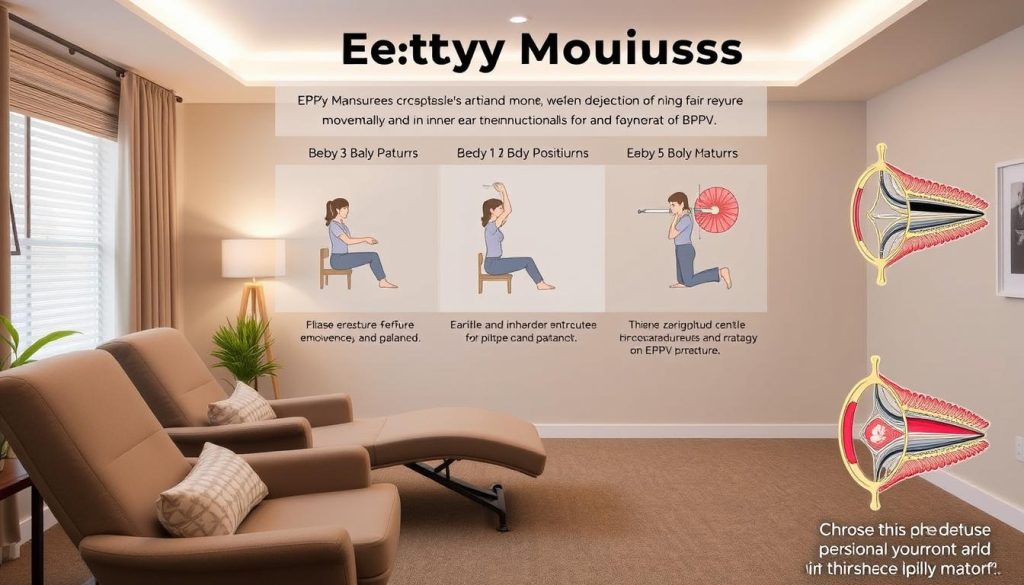Feeling dizzy? You might have BPPV vertigo. This inner ear condition can throw your balance off and make you feel like the room is spinning. But what is BPPV vertigo exactly? It’s a common type of vertigo that affects many people.
BPPV stands for Benign Paroxysmal Positional Vertigo. It happens when tiny calcium crystals in your inner ear get dislodged. These crystals play a key role in your balance system. When they move to places they shouldn’t be, it causes vertigo.
The causes of vertigo can vary, but BPPV often occurs without a clear reason. Sometimes it’s linked to head injuries or aging. Symptoms of BPPV include sudden dizziness, especially when you move your head. Don’t worry, though. There are effective treatments available to help manage this condition.
What Is BPPV Vertigo: Understanding the Basics
BPPV vertigo, or Benign Paroxysmal Positional Vertigo, is a common balance disorder. It affects millions of people around the world. To understand BPPV vertigo, we need to know about our balance system and how it gets disrupted.
The Inner Ear Structure and Balance System
Our inner ear is key to keeping our balance. It has tiny calcium crystals called otoconia. These crystals help us feel movement and gravity. When they move out of place, they can cause the spinning feeling of BPPV.
How BPPV Affects Your Balance
BPPV vertigo happens when otoconia move into the semicircular canals of the inner ear. This makes your brain think you’re moving, even if you’re not. You might feel dizzy and lose your balance. Knowing how this works is important for managing vertigo well.
Common Misconceptions About BPPV
Many people get BPPV wrong, mixing it up with other vertigo types. Let’s set the record straight:
| Misconception | Reality |
|---|---|
| BPPV is a lifelong condition | It can often be treated effectively |
| Medication is the only vertigo relief | Repositioning maneuvers are often more effective |
| BPPV affects only older adults | It can occur at any age |
Knowing what BPPV vertigo is and how it affects us helps patients find the right treatment. This way, they can get better vertigo relief.
Identifying Common Symptoms of BPPV
It’s important to know the symptoms of BPPV early. This helps in getting the right treatment. Understanding the signs is the first step towards relief.
Primary Symptoms and Warning Signs
The main sign of BPPV is feeling like you’re spinning or dizzy. This feeling usually lasts a few seconds to a minute. You might also feel nauseous, lose your balance, or feel unsteady.
Some people feel like the room is moving around them. These symptoms can be scary but knowing them helps.
Distinguishing BPPV from Other Types of Vertigo
BPPV is different from other vertigo because of its triggers and how long it lasts. It’s caused by specific head movements and goes away quickly. Other vertigos can last for hours or days.
BPPV doesn’t cause hearing loss or ringing in the ears. This is unlike some other vertigo conditions.
When Symptoms Typically Occur
BPPV symptoms often happen when you change how you’re holding your head. Common triggers include:
- Rolling over in bed
- Tilting the head back
- Bending down
- Getting in or out of bed
Managing vertigo means knowing these triggers. This way, you can avoid them and prepare for BPPV episodes.
| Symptom | BPPV | Other Vertigo Types |
|---|---|---|
| Duration | Seconds to minutes | Hours to days |
| Trigger | Specific head movements | Varies or constant |
| Hearing Changes | No | Possible |
| Balance Issues | During episodes | Often persistent |
Primary Causes and Risk Factors of BPPV
BPPV vertigo is a common cause of dizziness. It happens when tiny calcium crystals in the inner ear move out of place. Knowing why BPPV occurs can help prevent and treat it.

Age is a big factor in BPPV. As we get older, our inner ear wears down, raising the risk. Head injuries can also cause BPPV by moving the crystals.
Being on bed rest for a long time can also lead to crystal movement. This is true whether it’s due to illness or surgery.
Certain health issues can make BPPV more likely. Conditions like migraines, inner ear infections, and Meniere’s disease can raise your risk. Osteoporosis, which weakens bones, might also affect the inner ear’s delicate structures.
Genetics might also play a part, with some people being more prone to BPPV. Women are more likely to get BPPV, especially after menopause. A lack of vitamin D has also been linked to more BPPV episodes.
| Risk Factor | Impact on BPPV |
|---|---|
| Age (over 50) | High risk |
| Head Trauma | Significant trigger |
| Prolonged Bed Rest | Moderate risk |
| Osteoporosis | Increased susceptibility |
| Gender (Female) | Higher incidence |
Understanding BPPV vertigo and its causes can help you get the right treatment. If you keep getting vertigo, see a doctor for help.
Diagnosing BPPV: Medical Tests and Procedures
Diagnosing BPPV vertigo involves several medical tests and procedures. These help doctors find the cause of your symptoms and rule out other conditions. The process includes physical exams and specific diagnostic tests.
Physical Examination Methods
Doctors use different physical examination techniques to check for BPPV. The Dix-Hallpike test is a common method. It involves quick head movements to trigger vertigo symptoms. Another test is the supine roll test, which checks for horizontal canal BPPV.
Diagnostic Testing Procedures
Beyond physical exams, several diagnostic tests help confirm BPPV:
- Videonystagmography (VNG): Tracks eye movements during balance tests
- Vestibular evoked myogenic potentials (VEMP): Evaluates inner ear function
- Audiometry: Assesses hearing to rule out other ear disorders
Understanding Test Results
Test results guide treatment for BPPV vertigo. Positive Dix-Hallpike or supine roll tests often confirm BPPV. VNG results showing specific eye movements can indicate which ear is affected. This information is crucial for managing vertigo and developing an effective treatment plan.
| Test | Purpose | BPPV Indication |
|---|---|---|
| Dix-Hallpike | Trigger vertigo symptoms | Positive if vertigo occurs |
| VNG | Track eye movements | Specific nystagmus patterns |
| VEMP | Assess inner ear function | Abnormal responses in affected ear |
Essential BPPV Treatment Options
BPPV vertigo can really disrupt your life, but there are effective treatments. The right one for you depends on your symptoms and how bad they are. Let’s look at some key options that can help with vertigo relief.
Canalith repositioning procedures are a mainstay of BPPV treatment. These movements try to move displaced otoconia back where they belong. The Epley maneuver is a common one that often helps patients quickly.
BPPV vertigo exercises are also key. You can do exercises like the Brandt-Daroff technique at home. They help manage symptoms and prevent them from coming back. Your doctor or physical therapist can teach you how to do these exercises right.
- Canalith repositioning procedures
- Home-based BPPV vertigo exercises
- Vestibular rehabilitation therapy
- Medication for symptom management
- Surgery (in rare cases)
Vestibular rehabilitation therapy is for those with ongoing balance problems. It’s a type of physical therapy that helps your brain better understand balance.
Your doctor might suggest medications for vertigo symptoms. These are usually used for a short time to help while other treatments work. Surgery is an option for severe, lasting cases, but it’s not common.
Remember, the best treatment for BPPV vertigo is different for everyone. Work with your healthcare provider to find a plan that fits your needs and gives you lasting relief from vertigo.
The Epley Maneuver and Other Repositioning Techniques
BPPV maneuvers are key in treating vertigo. The Epley maneuver is a top choice among these exercises. It helps move otoconia in the inner ear, giving relief to about 80% of people.

Step-by-Step Guide to the Epley Maneuver
The Epley maneuver involves a series of head positions:
- Sit upright on a bed, turning your head 45 degrees to the affected side.
- Quickly lie back with your head hanging off the bed’s edge.
- Hold this position for 30 seconds.
- Turn your head 90 degrees to the opposite side.
- Roll onto your side, keeping your head in position.
- Slowly return to a sitting position.
Alternative Repositioning Exercises
Other exercises like the Semont and Foster maneuvers also help. They offer similar benefits and can be chosen based on comfort and effectiveness.
Safety Precautions During Maneuvers
When doing BPPV maneuvers, safety is key. Always talk to a healthcare professional first. Do them in a safe place to avoid falls. If dizziness gets worse or doesn’t go away, get medical help right away.
“The key to successful BPPV treatment is proper diagnosis and careful execution of the repositioning maneuvers.”
Regular practice of these techniques can greatly improve vertigo relief. It can also enhance the quality of life for those with BPPV.
Medications and Medical Interventions for BPPV
The Epley maneuver is a common treatment for BPPV vertigo. But, some cases need more help. Doctors might give medications to help with vertigo and symptoms. These can include antihistamines, anticholinergics, or benzodiazepines.
Antihistamines like meclizine can lessen dizziness and nausea from BPPV. Anticholinergics, such as scopolamine patches, help control symptoms for a short time. For severe cases, benzodiazepines like diazepam can help with anxiety and dizziness.
It’s key to remember that these medicines don’t fix BPPV. They just help manage symptoms while treatments like the Epley maneuver work on the cause.
| Medication Type | Examples | Primary Use |
|---|---|---|
| Antihistamines | Meclizine, Dimenhydrinate | Reduce dizziness and nausea |
| Anticholinergics | Scopolamine | Short-term symptom control |
| Benzodiazepines | Diazepam, Lorazepam | Alleviate anxiety and dizziness |
In rare, persistent cases of BPPV, surgery might be an option. This includes plugging the affected semicircular canal or cutting the nerve for balance signals. But, these surgeries are usually a last resort because of risks and complications.
Lifestyle Modifications and Prevention Strategies
Living with BPPV vertigo can be tough, but there are ways to manage it. Simple changes in your daily life and surroundings can help. This can lead to better vertigo relief and a higher quality of life.
Daily Habits to Reduce Episodes
Some daily habits can help lessen vertigo episodes:
- Stay hydrated by drinking plenty of water
- Get enough sleep and maintain a consistent sleep schedule
- Practice stress-reduction techniques like deep breathing or meditation
- Engage in regular vestibular rehabilitation exercises
Environmental Modifications
Changing your surroundings can also help with vertigo relief:
- Install nightlights to prevent sudden movements in the dark
- Use non-slip mats in the bathroom and shower
- Keep frequently used items within easy reach
- Remove tripping hazards like loose rugs or clutter
Long-term Management Techniques
For long-term vertigo management, try these strategies:
| Technique | Benefits |
|---|---|
| Regular balance exercises | Improves stability and reduces fall risk |
| Vestibular rehabilitation therapy | Enhances brain’s ability to process balance information |
| Mindfulness practices | Reduces stress and anxiety associated with vertigo |
| Dietary adjustments | Limits triggers that may worsen symptoms |
By making these lifestyle changes and prevention strategies, you can manage your BPPV vertigo better. This can lead to lasting relief.
Recovery Timeline and Long-term Outlook
The path to getting better from BPPV vertigo is different for everyone. Many people start to feel better within a few days or weeks after treatment. The Epley maneuver often helps quickly, with some noticing improvements after just one or two tries.
For those dealing with vertigo over time, it’s key to remember that BPPV can come back. Around 50% of people might see symptoms again within five years. Regular check-ups with doctors can help catch and treat any new episodes early.
The good news is that BPPV usually doesn’t cause serious problems. With the right care and management, most people can keep their symptoms under control. Staying active, doing exercises as prescribed, and making small lifestyle changes can help a lot. These steps can prevent future episodes and improve overall balance health.
FAQ
Q: What is BPPV vertigo?
A: BPPV (Benign Paroxysmal Positional Vertigo) is a disorder of the inner ear. It causes brief dizziness when you move your head. This happens when tiny crystals in your ear get out of place, disrupting balance.
Q: What are the main symptoms of BPPV?
A: Symptoms of BPPV include sudden, brief vertigo or spinning. It’s often triggered by head movements like looking up or lying down. You might also feel nauseous, lose balance, or feel unsteady.
Q: How is BPPV diagnosed?
A: Doctors diagnose BPPV through physical exams and tests. The Dix-Hallpike maneuver is a common test. It involves moving your head to check for eye movements typical of BPPV. Sometimes, more tests like videonystagmography (VNG) are needed.
Q: What causes BPPV?
A: BPPV can happen on its own or due to head trauma, infections, or prolonged bed rest. Age can also play a role. Often, the exact cause is unknown.
Q: What is the Epley maneuver?
A: The Epley maneuver is a treatment for BPPV. It involves head movements to move crystals back into place. A healthcare provider performs it, but you can also learn to do it at home.
Q: Are there any medications for BPPV?
A: Medications like anti-vertigo drugs might be prescribed for BPPV symptoms. But they don’t fix the problem and are usually used for a short time.
Q: How long does it take to recover from BPPV?
A: Recovery time for BPPV varies. Many see improvement in a few days to weeks. Some might get better without treatment. But, BPPV can come back, so ongoing care is often needed.
Q: Can BPPV be prevented?
A: Preventing BPPV is hard, but some habits can lower the risk. Avoid sudden head movements and sleep with your head up. Also, do vestibular rehabilitation exercises as advised by a doctor.
Q: Are there any home remedies for BPPV vertigo?
A: Home remedies like Brandt-Daroff exercises and staying hydrated might help. Avoiding caffeine and alcohol can also help. But, always talk to a doctor before trying any self-treatment.
Q: Can BPPV affect both ears?
A: Yes, BPPV can affect both ears at once. This is called bilateral BPPV. It might need more complex treatment.

















